Mike Vardy's Blog, page 55
November 22, 2017
Break the Twitch with Anthony Ongaro
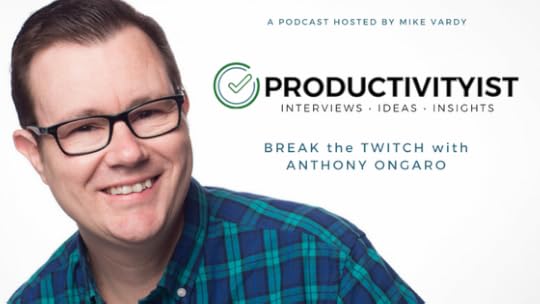
Joining me this week on the podcast is Anthony Ongaro, creator of Break the Twitch and author of the book Break The Twitch: A Practical Guide to Minimalism and Intentional Living.
We talk about what he defines as the “twitch,” the three things Anthony focuses on what can help you break the twitch, impulsiveness and its effect on personal productivity, and why “it’s not about the couch.”
Relevant Links:
Minimalism: A Documentary About the Important Things | The Minimalists
The More of Less with Joshua Becker | The Productivityist Podcast
No couch, one car: How These Minnesotans are Living with Less | StarTribune
SimpleREV 2014 | How to Stop Doing Productive and Start Being Productive
SimpleREV 2014 | Anthony Ongaro’s Story
Break the Twitch | Website
The Break the Twitch Newsletter
Break the Twitch | Youtube
Thanks for listening. If you enjoyed the show don’t forget to subscribe so you don’t miss a single episode. Until next time remember to stop guessing…and start going!
If you’re interested in supporting the podcast and receiving exclusive content while doing so, you’ll want to check out the patrons-only version of The Productivityist Podcast on Patreon. Also, remember to leave The Productivityist Podcast a rating and review on iTunes, or on whatever platform you’re listening to. I read every single bit of feedback we receive. I want to make this show better and with your help I can do that.
The post Break the Twitch with Anthony Ongaro appeared first on Productivityist.
November 20, 2017
When (And How) The “Time Theming” Mindset Doesn’t Work
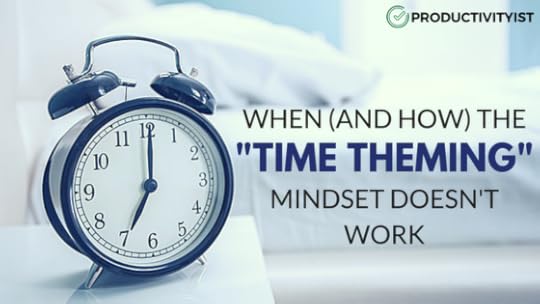 Time Theming works really well when used in the broadest of senses.
Time Theming works really well when used in the broadest of senses.
You can define your day, have a specific focus for your month, or even have a clearly assigned block of time set aside during the day to work on something that only you can work on. (For example, I like to use a Horizontal Theme of writing).
It works in those cases because it can be consistent…and you need it to be consistent. If an approach isn’t consistent, then it won’t work.
Ultimately, this mindset allows you to work by task over time.
The Time Theming mindset doesn’t work when you apply it to appointments of any sort – even those that you usually have on the same day and time. Why?
Because you don’t have complete control over them. Someone else is in the mix. Essentially, it’s those irregular and inconsistent appointments that force you to work by time over task.
That’s why it is important to look at your calendar and confirm those inconsistencies every day.
Otherwise, you run the risk of making assumptions about appointments involving others, and that can create a risk of missing appointments altogether.
How do I know this?
It’s happened to people I work with. It’s happened to me.
So here’s a good rule of thumb when it comes to using your calendar with the Time Theming mindset – and TimeCrafting as a whole:
Have your Time Themes in your calendar (Daily, Monthly, Horizontal, and Weekly Sprints). These will serve as reminders of you’ve defined your time so that your intentions get your attention consistently.
Check your calendar for future specific appointments. You’ll want to look in advance – even the day before as a final confirmation – so that you don’t miss an event that is irregular or inconsistent. This will help you work your tasks for the day around those specific events.
I wrote this for me just as much as I wrote it for you. Now let’s try to keep it in mind moving forward.
The post When (And How) The “Time Theming” Mindset Doesn’t Work appeared first on Productivityist.
November 15, 2017
Being Adaptive with Karim Bishay
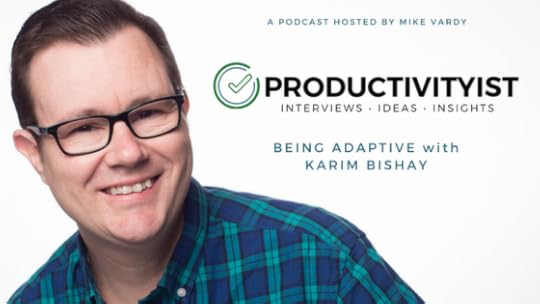
Karim Bishay helps companies become insanely efficient. His purpose at Living Orgs is to empower organizations towards a clear, agile structure and stronger purpose. He is an industry leading consultant in the areas of Holacracy and building Adaptive Organizations.
During this episode we talk about why he started Living Orgs, what drew him to Holacracy, how he works with organizations to make them more adaptive, and how he deals with the challenges that aligning teams can bring when change is needed. It’s always great when I can chat with someone who is well-steeped in the world of productivity, so this episode is filled with plenty of personal productivity goodness.
Relevant Links:
Living Orgs
Making Teamwork Work with Sebastian Klein of Blinklist | The Productivityist Podcast
Meetings and Momentum with Mamie Kanfer Stewart | The Productivityist Podcast
Crafting Coaches with Tony Stubblebine | The Productivityist Podcast
Holacracy 101
Do Better with Asana
Thanks for listening. If you enjoyed the show don’t forget to subscribe so you don’t miss a single episode. Until next time remember to stop guessing…and start going!
If you’re interested in supporting the podcast and receiving exclusive content while doing so, you’ll want to check out the patrons-only version of The Productivityist Podcast on Patreon. Also, remember to leave The Productivityist Podcast a rating and review on iTunes, or on whatever platform you’re listening to. I read every single bit of feedback we receive. I want to make this show better and with your help I can do that.
The post Being Adaptive with Karim Bishay appeared first on Productivityist.
November 13, 2017
I Tried To Juggle Life, But This Is Better
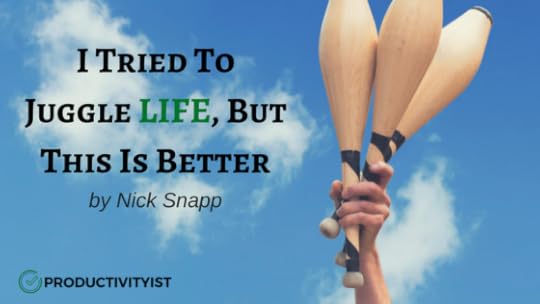
Today’s guest post is by Nick Snapp. Nick is an engineer, podcaster, and recovering perfectionist. He is also in charge of innovation at Snappier, a platform designed to train you to become a Finisher. For Nick’s free, in-depth guide on how to test your next business idea without wasting time and money, go to Snappier.co/idea.
I won’t say that Dementia runs in my family, but I’ve seen my fair share of it. This condition absolutely terrifies me. Dementia is a brain disease that decreases a person’s ability to think and remember.
The one thing that makes me who I am, slipping away as I age? That’s just not acceptable. There has to be a way to combat this!
So I decided to carve out some time to figure out a productive way to address my fears.
What Research Says
Now let me preface by stating that I’m not, by any stretch of the imagination, a medical professional. However, I have done my research, and I’ve formed a somewhat educated opinion. The good news is I’m convinced there’s hope. And, for me, hope is all I need to take action.
Let’s start with your own personal experience with Dementia. Picture those people most affected by this horrible disease in your personal life. Did you see any life patterns? I sure did.
I saw a lack of activity: a lot of television watching, solitude, inactivity, and monotony. So if there’s a correlation between an inactive mind and brain disease, my first question is what can be done about it now?
Our Daily Routines
If something can be done to mitigate the risk of brain disease, it’s likely to have something to do with what we do every day. Routines work. You can theme your days, sleep and eat around the same time, and have other good habits. Yet, problems arise when routines become mundane or filled with minutia that people stop learning and developing.
It’s a serious issue we often don’t think about.
I’m a parent of three small boys, so I get it. Implementing a good routine is critical for getting things done around the house. You’ve got to be on point in all areas when you have a family. Even so, it’s scary how incredibly easy it is for the weeks and months to slip by. It can even be easy to stop learning.
I fell victim to unhealthy routines. I used to have it all figured out: I had a dedicated amount of time carved out every morning. I would read, take courses, listen to podcasts, I’d soak it all up before I did anything else. Before kids, there was a time in my life that I listened to so many audio courses I became conversational in three languages within a year.
Then, those sweet bundles of joy came around. Shortly after that, I left my corporate career to start a business. The pressure at home ensued. I felt like another American statistic, juggling the never-ending facets of a dual-income family with kids. As time passed, learning became less of a priority, and it eventually slipped away without me noticing.
When You Stop Learning
Once I stopped learning, a fog hovered over my consciousness. I’d have trouble thinking and coming up with original ideas. It was a little weird, even depressing. Brain disease in my mid-thirties? No way. Adult-ADD maybe?
Fortunately, a friend of mine to told me about synapse. He told me he’d been brushing his teeth with his left (non-dominant) hand. At first didn’t get it. I also thought it was a little extreme, but something inside told me to give it a shot.
Brushing my teeth in this way was painfully difficult at first, but I persisted. After about two weeks, it became really easy. I was amazed when I picked up the toothbrush with my left hand and started brushing without thinking about it…what happened?
From what I understand, I had strengthened my synapses. These are signal transmissions between neurons in my brain. Synapses are believed to be the underlying mechanisms responsible for learning and memory.
The cool thing about synapses is that studies show the brain is adaptive. When the brain is damaged by injury or disease, it can re-wire itself by building new neurons and synapse connections. That’s exactly what happened when I started brushing with my left hand. I felt clarity from this exercise. Ideas came more rapidly, and my mood lightened…I wanted more!
So I decided to take things to the next level.
Take on Something New
Here’s the challenge (and also the excuse) for most parents…you don’t have time.
I get that.
Your time is not your own when you’re a parent. But what if you could form new synapse connections while you parent our kids? Could you learn new things without alienating yourself from your family?
I was outside playing with my kids one afternoon and noticed we had three hacky sack balls. Then I remembered how I had taken the kids to an event earlier that year. A juggler put on an amazing show for about 30 minutes. Afterwards, he was selling hacky sack balls in packages of three. My kids just had to have them.
Juggling is something I’ve always been curious about, so I picked them up and gave it a try.
My kids watched as I tossed the items into the air and dropped them just as soon as they left my hands. I noticed that the kids were still playing calmly, and my juggling attempt didn’t hinder my ability to keep them safe.
So, I kept tossing.
Soon, my 16-month old was helping me pick the balls up off the ground and handing them back to me. It was pretty cool. There I was, a grown, late 30’s man learning to juggle while parenting like a champion!
I continued my efforts, any chance I had: when the kids were playing outside, while my wife was watching Netflix, whenever. I leveraged those little pieces of time found randomly in life: 30 seconds here and 10 minutes there. I tossed consistently for about 30 days using this approach. I was so horrible!
Then, something clicked…synapses were formed.
Practice Practice and More Practice
I started counting tosses, and I eventually hit 100. It was really invigorating, considering I hadn’t made any real sacrifices whatsoever to acquire this new skill.
There was a side benefit too. In 30 days, my kids saw their dad go from a complete beginning juggler to someone that could actually juggle. They saw me consistently putting in the work, and they even took an interest!
There came a time when the kids were juggling my hacky sack balls so much that I started missing my juggling time. Nevertheless, I was happy to let them take a crack at it because they were implementing something they learned from me. Here were my two kids spending over 30-minutes consistently tossing and dropping balls in the air with their newfound quest to juggle.
Simply. Amazing.
Multi-Tasking is a Myth…But Still
The fact that I was able to learn how to juggle, AND be an active parent to my kids was impressive to me. It even totally opened my eyes to other avenues for learning while parenting.
I see juggling and similar activities as a new way to take breaks while you’re in the middle of your day without taking you away from what’s important.
Don’t be fooled though. Not all of your “one day I’m going tos” will qualify for synapse growth at home. You can’t exactly pursue rock climbing in between potty training.
Home-Synapse Growth Activities (HSGA’s, as I like to call them) need to be accessible. Where’s that old guitar of yours these days? How about mounting it on the wall in the family room? You can practice some chords in between loads of laundry and your kids can see you rocking out.
Your kids will witness your newfound interests, and you’ll develop new, healthy habits. HSGA’s shouldn’t require much focus, and they need to be interruption-friendly. Here are some activities you can try:
Learning an instrument
Reading a book
Card tricks
Memory games
Drawing/painting
Air squats
Push-ups (yep, exercises count too)
There are so many possibilities here. It just takes a little conscious thought and some action. The best way to do this is to setup your environment to make it easy. My hacky sack balls were always within arm’s reach.
What have you always wanted to learn how to do? Think about your current schedule and whether you could get it done as an HSGA (that acronym will catch on, just you wait and see).
The post I Tried To Juggle Life, But This Is Better appeared first on Productivityist.
November 8, 2017
Behind the Scenes with Dexter Guff and Peter Oldring
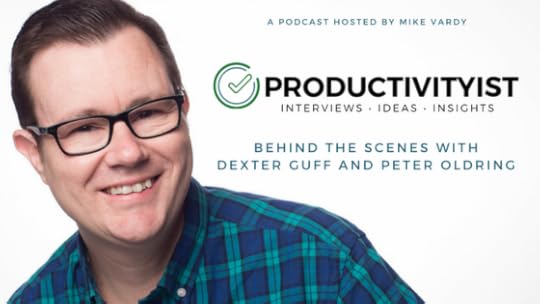
On this episode of the show, I am delighted to have two guests join me. First up is thought leader and podcast host Dexter Guff, host of Dexter Guff is Smarter Than You (And You Can Be Too) and following his appearance I speak with his alter ego, comedic performer Peter Oldring.
While Dexter and I discuss a lot of the usual lifehackery stuff, Peter and I dive deeper into what makes Dexter tick. We talk about how he and his colleagues Pat Kelly and Chris Kelly (no relation) came up with the idea of doing Dexter’s reaction the show has received so far, how the show is crafted every week, and where the show is headed.
This is a different kind of episode – and a little longer than usual – but it’s a fun one.
Relevant Links:
Dexter Guff is Smarter Than You (And You Can Be Too) by Panopaly | iTunes
Peter Oldring on his podcast Dexter is Smarter Than You
The Truth About Fake News | Peter Oldring | TEDxYYC | Youtube
This is That with Pat Kelly and Peter Oldring | CBC Radio
Dexter Guff | Twitter
Peter Oldring | Twitter
Peter Oldring | Wikipedia
Thanks for listening. If you enjoyed the show don’t forget to subscribe so you don’t miss a single episode. Until next time remember to stop guessing…and start going!
If you’re interested in supporting the podcast and receiving exclusive content while doing so, you’ll want to check out the patrons-only version of The Productivityist Podcast on Patreon. Also, remember to leave The Productivityist Podcast a rating and review on iTunes, or on whatever platform you’re listening to. I read every single bit of feedback we receive. I want to make this show better and with your help I can do that.
The post Behind the Scenes with Dexter Guff and Peter Oldring appeared first on Productivityist.
November 1, 2017
“No, Fear.”

When I decided to turn comments off here at Productivityist, it had me thinking about how I look at – and face – Fear.
(Fear deserves to be given a proper name in this instance because it is just so prevalent and real. Just like Pressfield has with The Resistance, I have given Fear its due.)
I’ve written about my passion for all things Green Lantern here before, and I still wear my ring most of the time. I always wear it when I’m feeling like I need the willpower to move forward with something (the process of writing, when faced with making tough decisions, etc.), and it does help me face the Fear that I find comes with moving forward. Why do I believe that Fear pushes its way to the forefront as I try to make progress? Because I’m often entering (somewhat) uncharted waters.
In the instance of turning off the comments here on the blog, I’ve never had a blog without the comments turned on. I’ve left the comments on – even when others turned them off – to keep an open room and discussion happening here on the site. But I’d been contemplating turning them off for a long time because so much more conversation is happening over on social media sites and the spam comments are becoming increasingly worse and more frequent.
Ultimately I decided to turn comments off. I risk lowering engagement here and, in turn, needing to spend more time on Facebook and Twitter. I am afraid of splitting my focus because of this decision. I am afraid of the overall conversations surrounding our content dropping. I am afraid of backlash.
But I need to say no to Fear. The best way I can do that and mean it is by ensuring I pay attention to those social sites. That will boost my confidence and go a long way towards keeping Fear at bay.
Make no mistake, Fear loves to show up and rain on parades as often as possible. Over the years I’ve been presented with a slew of great opportunities, many of which “The Resistance” (another name for Fear as coined by Steven Pressfield) has tried to – and continues to try to – sabotage.
Fear has told me that I’m not ready for these challenges. It has said that I’m not good enough to make the most of them. It has said they will get in the way of other things. It has said that something will go wrong.
And something will go wrong if I don’t acknowledge what Fear is saying and strive to avoid those pitfalls. Fear is trying to tell me what stands in my way – Fear itself isn’t in the way. That’s what my ring does for me. It acts as a means of helping be aware of what Fear will show me and furthers my resolve to make sure I don’t fall prey to those concerns. Because if that was to happen, then those concerns have become far more than that. They’ve become fact.
Besides the ring I wear, the tools I use act as a saving grace as well. The foundation I’ve laid with my task manager, the TimeCrafting methodology I’ve adopted (and adapted over time), and the strategies I employ all help to keep me anchored. When I feel like I’m going astray, all of those things either bring me back or keep me on track. Just like Fear, they are touchstones that keep me informed so that I can better perform. And then get even better at performing.
Remember the slogan “No Fear” that was so prominent in the late 80s and early 90s? I think it makes more sense to have a comma inserted between the two words instead. After all, we need to acknowledge that Fear is going to turn up in our lives – we just need to say “No, Fear” after we let it do its job and say “Yes” to what we want, need, and should pursue afterward.
The post “No, Fear.” appeared first on Productivityist.
Fit Matters with Moe Carrick
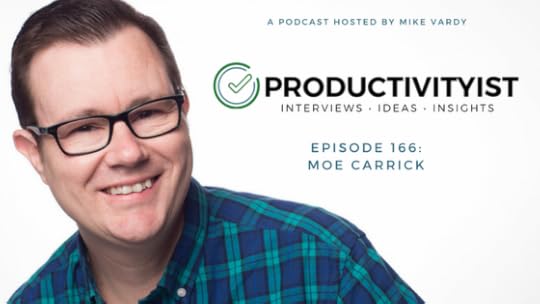
On this episode of the podcast, I talk with Moe Carrick. She is the founder of Moementum Inc., and she loves to help leaders transform themselves and their companies. Her book, Fit Matters: How to Love Your Job, with Maven House Press, was released May 2017.
During our discussion we touched on what she calls The Six Elements of Work Fit, what “flexing” is and how it can help you with getting the right fit in your work, workforce trends that impact fit (and dive into the ones I’ve struggled with myself), what to do when not all of the elements align at work, and more. If you’re trying to figure out whether or not your work is suitable for you, then this episode is going to be a great…fit.
Relevant Links:
Moementum
Fitmatters.biz
So Good They Can’t Ignore You | Cal Newport
Amy Wrzesniewski | Yale School of Management
Moe Carrick | Website
Thanks for listening. If you enjoyed the show don’t forget to subscribe so you don’t miss a single episode. Until next time remember to stop guessing…and start going!
If you’re interested in supporting the podcast and receiving exclusive content while doing so, you’ll want to check out the patrons-only version of The Productivityist Podcast on Patreon. Also, remember to leave The Productivityist Podcast a rating and review on iTunes, or on whatever platform you’re listening to. I read every single bit of feedback we receive. I want to make this show better and with your help I can do that.
The post Fit Matters with Moe Carrick appeared first on Productivityist.
October 25, 2017
Why I’ve Stopped Saying That You Shouldn’t Check Email First Thing In The Morning
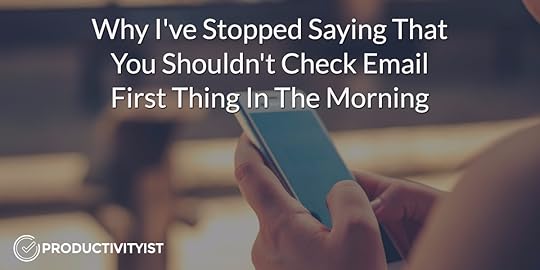
For a long time, I’ve believed that you should not check email first thing in the morning. As a matter fact, I still don’t. But the truth is, that advice won’t work for everybody.
So I’ve stopped saying it.
I think what’s more important is that you have a strategy whenever you open your email application – no matter when you do it. If a strategy is not in place, you could find yourself stuck in email all day long.
There are some simple ways to be more efficient with email. I am going to present a couple of ideas that I regularly employ that are worth considering.
First off, I have scheduled communication breaks. There are times of day where I will check social media direct messages on Twitter, Facebook, and LinkedIn. Those are online platforms where people are trying to connect with me, and they don’t have their email address handy. Essentially, that means they are people that I’ve never communicated with personally. I’m going to communicate with them differently than I would with anyone who does have my email address.
There is an episode of Buffers Science of Social podcast that talks about how social media has changed. I think that if you’re looking to figure out why I employ the strategy now, you should give this episode a listen.
If you’re not sure when is the best time of day to check your social media direct messages, look at studies that show when people are using social media most often. I’m not suggesting that you should tether the time spent each platform to the time to each platform has the most users, but maybe you can find the best time(s) to check those messages. I personally only check them once a day. Normally, if a task is born from one of those messages, I immediately added it to my task manager.
This is why it’s critical not to use your email account as a task manager. Each of us receives communication from so many different places every day. It’s best to centralize all your tasks in one place, regardless of where they are coming from.
When you use many of the extensions for popular task managers (such as Todoist) with your email (and through your browser), you can essentially put anything your receive into your task manager quickly and seamlessly.
Another thing that I do – and highly recommend – is that if you were working with people on a team, try to create a silo for that kind of communication outside of email. For example, you could use a tool like Slack to communicate internally with your colleagues.
Alternatively, many of the popular project and task management tools have communication and conversation built into those apps. You can have conversations take place in those apps instead of an email. This approach allows you to know that any internal communication is happening either within that specific communication tool or in your team’s internal task manager.
When you state your needs (based on tactics and strategies and play), it allows you to have more flexibility as to when you should check their email. By segmenting the different types of communication, you can put yourself in a position to be a more effective communicator.
If you have a small amount of email, you can check it early in the morning. Then you can categorize those types of communications and make decisions with them.
Whatever time you open up your email, please remember to have a clear strategy in place. That will help you move forward and take your productivity to the next level.
The post Why I’ve Stopped Saying That You Shouldn’t Check Email First Thing In The Morning appeared first on Productivityist.
Meetings and Momentum with Mamie Kanfer Stewart
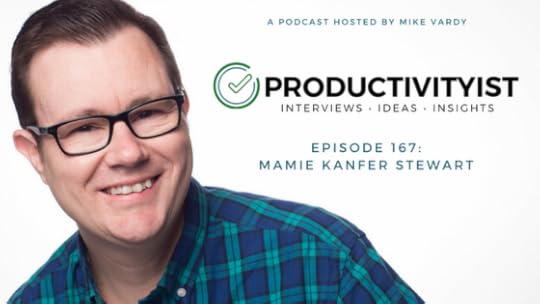
I welcome Mamie Kanfer Stewart to the show on this episode. She is CEO and founder of Meeteor, a venture that helps teams build their capabilities for effective collaboration and productive meetings. Mamie is driven to help others optimize their time and cultivate their team to achieve results.
On this episode we talk about meeting strategies and pitfalls to avoid, such as how to avoid back-to-back meetings, going into a meeting with not enough information, dealing with late meetings attendees, and whether or not status meetings are useful when done right (or useless no matter what). If you want to get more out of your meetings – whether you love them or don’t – then this episode is for you.
Relevant Links:
Momentum: Creating Effective, Engaging and Enjoyable Meetings
Meeteor
Why a ‘No-Meeting Day’ Doesn’t Get at the Real Problem
How Do I Get My Team to Prepare for a Meeting
Mamie Kanfer Stewart | Website
Mamie Kanfer Stewart | Twitter
Meeteor | Twitter
Thanks for listening. If you enjoyed the show don’t forget to subscribe so you don’t miss a single episode. Until next time remember to stop guessing…and start going!
If you’re interested in supporting the podcast and receiving exclusive content while doing so, you’ll want to check out the patrons-only version of The Productivityist Podcast on Patreon. Also, remember to leave The Productivityist Podcast a rating and review on iTunes, or on whatever platform you’re listening to. I read every single bit of feedback we receive. I want to make this show better and with your help I can do that.
The post Meetings and Momentum with Mamie Kanfer Stewart appeared first on Productivityist.
October 18, 2017
Standing Up with Rob Jacobs
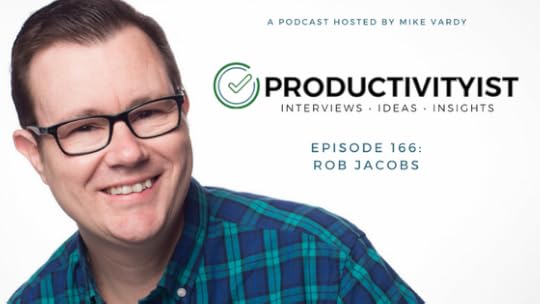
On this episode of the show, I speak with Rob Jacobs. Rob is a leader in the walking for health movement and the co-founder of Unsit – a company that created the first ever treadmill you can use under your standing desk at work.
We talk about why standing simply works when it comes to boosting personal productivity, why sitting too long has similar effects as smoking, why walking is a great way to problem solve, and more. As someone who works standing up a good deal of time (I actually record most of my podcast interviews while standing), I really enjoyed diving deeper into this topic. I hope you’ll enjoy it as well.
Relevant Links:
Unsit
Get Up: Why Your Chair is Killing You and What to Do About It
Dr. Michael Breus | The Productivityist Podcast
Rob Jacobs | LinkedIn
Thanks for listening. If you enjoyed the show don’t forget to subscribe so you don’t miss a single episode. Until next time remember to stop guessing…and start going!
If you’re interested in supporting the podcast and receiving exclusive content while doing so, you’ll want to check out the patrons-only version of The Productivityist Podcast on Patreon. Also, remember to leave The Productivityist Podcast a rating and review on iTunes, or on whatever platform you’re listening to. I read every single bit of feedback we receive. I want to make this show better and with your help I can do that.
The post Standing Up with Rob Jacobs appeared first on Productivityist.



